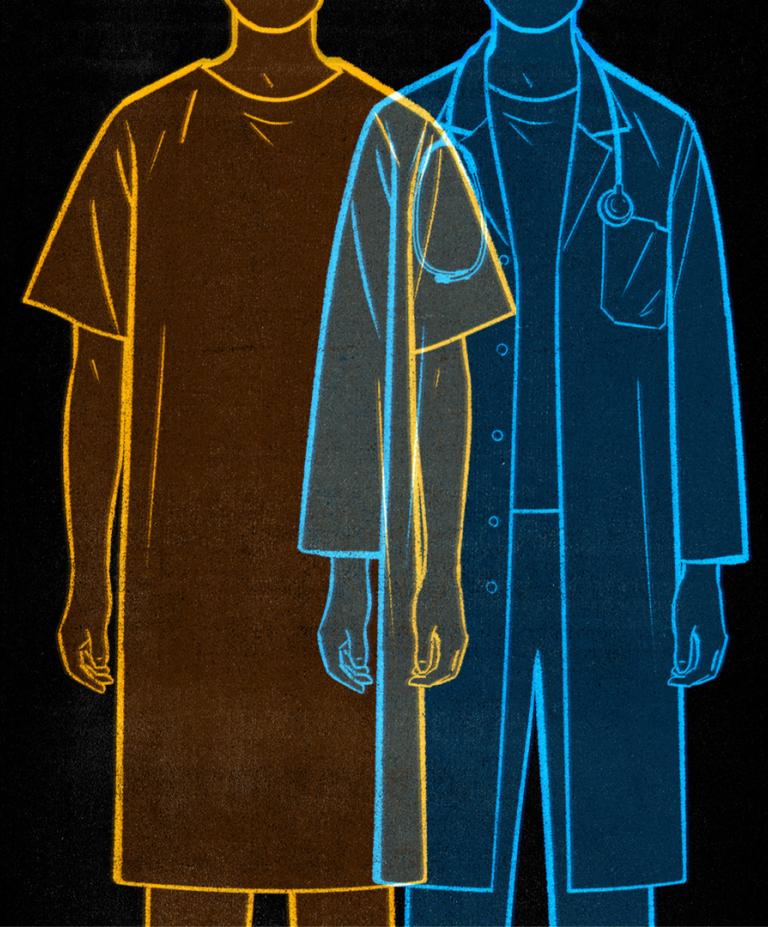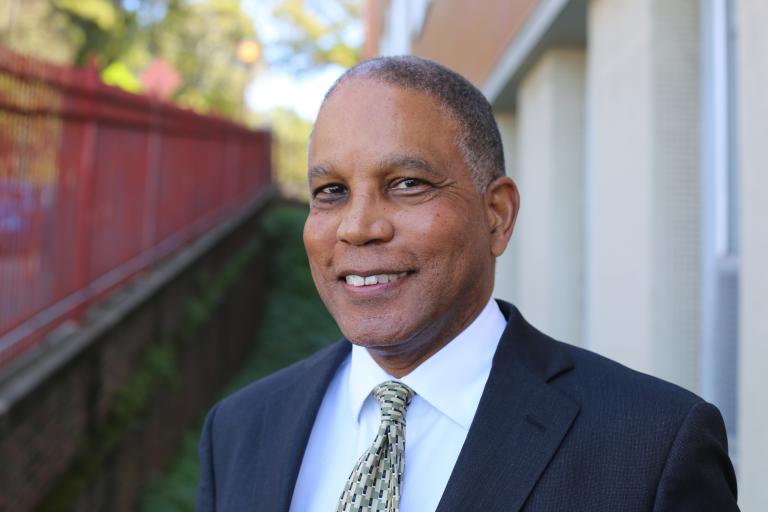Shared Identity and the Doctor-Patient Relationship
Patients with demographically similar physicians tend to report increased satisfaction. Do they also have better health outcomes?
- 7 minute read
- Feature

When third-year HMS student Michael Liu was in his clinical rotation at a practice specializing in sexual and gender minority health care, patients often expressed their gratitude at having health care providers who understood them. “Many would come all the way from the Cape or other parts of New England for care at Fenway Health,” Liu says, “even though there were plenty of providers they could have chosen closer to home.”
It’s hard to say for sure, Liu concedes, whether this choice was because of patients’ concordance with their physicians, meaning that they share a demographic similarity, but Liu wouldn’t be surprised if it were, since Fenway Health has many providers who themselves identify as part of the groups the practice serves.

“Having a provider who is not just educated in your health issues but also has a similar lived experience to you makes a lot of patients feel more comfortable,” he says, “especially in communities that may experience stigma or discrimination.”
The research on concordance
Investigating concordance in clinical settings is a relatively new idea. Early published research on concordance found that Black patients whose doctors were also Black reported participating more in their visits, and receiving more preventive care. They also tended to rate their physicians as excellent more frequently, while Hispanic patients who saw Hispanic physicians were more likely to say they were “very satisfied” with their care overall than those who saw non-Hispanic physicians.
Neil Powe, MD ’81, helped pioneer this field, contributing to several early studies that looked at both race and gender concordance in health care. “We had a very sophisticated system of measuring the types of communication between doctors and their patients, including whether their speech was slower and more interactive, and the visit longer,” says Powe, chief of medicine at the Priscilla Chan and Mark Zuckerberg San Francisco General Hospital and Trauma Center. “Our conclusion was that patients felt more at ease with concordant providers and trusted them more.”

Research indicates that concordance in the clinic has been associated with increased preventive care, follow-up visits, and adherence to treatment plans. “There are also studies that suggest resource utilization is better with concordance,” says Powe. “That is, fewer dollars are spent on a person’s medical care, because when you have better communication, imaging and other laboratory tests are less necessary to find out what’s going on.”
“There’s a huge literature in this field showing that when there’s concordance in race and ethnicity, people often do report receiving better care,” says Liu. “But we aren’t sure of the factors contributing to this. Is it because there’s less bias, better patient-provider communication, more openness? It’s hard to tell exactly, and the evidence points in many directions. Also, fewer studies have been done on whether this holds true for other kinds of concordance.”
In the past two decades, concordance in language, sexual and gender identity, parental or socioeconomic status, education, religion, and more have come under scrutiny, and the findings have often been similar. However, “while a number of studies show that concordance does affect patient satisfaction,” says Powe, “it’s harder to show an association with reduced mortality and morbidity. The results on that are mixed.”
What about physician bias?
One thing that has been linked to differences in health outcomes is implicit or explicit bias, and many underserved patient populations report experiencing it in health care settings. “Bias is not the same as lack of concordance, but it’s related,” says Alex Keuroghlian, director of the Division of Education and Training at The Fenway Institute and an HMS associate professor of psychiatry at Massachusetts General Hospital. “We tend to ‘otherize’ people who don’t share our experiences, and clinicians are not impervious to that.”
Studies have shown that health care professionals may view older patients, for example, as “offensive” and “demanding”; and patients who are clinically overweight or obese as “lazy, undisciplined, and weak-willed”; they are also less likely to view patients of low socioeconomic status as “intelligent, independent, responsible, or rational.” And, says Liu, there’s often a striking correlation between discordance and care avoidance, in large part, he says, because of perceived discrimination in health care settings. “But again,” says Liu, who is the lead author of a paper on this topic under review at a major medical journal, “there’s less national data about why sexual or gender minorities are avoiding care. Is it due to discordance, is it due to discrimination, is it due to other factors? That hasn’t really been studied.”
We tend to ‘otherize’ people who don’t share our experiences, and clinicians are not impervious to that.
One 2023 survey of 3,325 Black Californians found that more than a quarter of respondents avoid care due to concerns they will be treated unfairly or with disrespect, while the number is even higher among Black Californians who identify as LGBTQ+. Other research has found that disabled patients of color, too, are more likely to expect to encounter this sort of double discrimination.

“That’s why it’s so important to have this conversation in an intersectionality framework,” says Keuroghlian. “Patients may have multiple minoritized identities, and there may be concordance along one identity parameter and not another.”
Increasing diversity to improve concordance
The problem is that it’s simply not possible for every patient to find physicians who are concordant in the identities that matter most to them. “Black people and African Americans make up about 14 percent of the U.S. population,” says Powe, “but only about 5 percent of the physicians. The data are similar for Hispanic and Indigenous populations, and women are underrepresented in some specialties and overrepresented in others.” Similarly, while the percentage of medical students identifying as LGBTQ+ more or less mirrors that of the general population, says Keuroghlian, “there is a deficit in the existing workforce.”
And yet concordance is something that patients, like those Liu saw at Fenway Health, are actively seeking. “You hear all the time, ‘Can you find a therapist or coach who is like me?’” Powe says. “The jury is out on whether it really makes a difference, but it’s what people want.”
Powe and Keuroghlian both believe that increasing diversity in health care, especially in leadership positions, is one of the best ways to raise concordance for underserved populations. Powe serves on the advisory committee for the Harold Amos Medical Faculty Development Program supported by the Robert Wood Johnson Foundation, which aims to increase health equity by developing leaders from historically marginalized backgrounds.
“I have seen people go through that program who are now deans, presidents of universities, MacArthur ‘genius grant’ recipients, and chairs of departments,” he says. “The idea is they provide students with role models so they’ll feel more comfortable going to medical school.” Though last year’s Supreme Court decision ending affirmative action in college admissions might have a “chilling effect” at both the undergraduate and medical school level, Powe says, “we need to double our efforts and find ways within the law to continue to diversify the profession.”
I see people with no seemingly concordant identities establish incredibly profound and beneficial therapeutic relationships all the time.
Keuroghlian agrees, maintaining that promoting LGBTQ+ people to positions of leadership, developing proactive mentoring programs, and providing responsive benefits such as gender-affirming insurance options for employees can have an impact on concordance, especially in health care settings where specialized care is not available for certain patient populations.
However, he adds, it’s important to remember concordance isn’t strictly necessary to building trust and establishing open communication with patients. “I see people with no seemingly concordant identities establish incredibly profound and beneficial therapeutic relationships all the time,” he says. “If that weren’t possible, we’d have no hope for progress.”
Competent care despite difference
To help such relationships develop and flourish, Keuroghlian’s division at Fenway Health is working to increase cultural responsiveness by raising awareness of LGBTQ+ issues among physicians and other providers who are not members of those communities and training them in sensitive and effective care. That includes, Keuroghlian says, “asking every patient for their correct name and pronouns, apologizing when you make mistakes, and building a welcoming and affirming care environment, including establishing a community advisory board and a representative workforce.”
While cultural competence or diversity, equity, and inclusion training is “a tool in the arsenal,” Powe again notes that few studies positively correlate these to better health outcomes. “Intuitively, we think it should matter, but we need more research to understand what works best, what are the good kernels of DEI training that are the most helpful.” Because physician learners are busy, he says, the training experiences must be as meaningful as possible.
“There are many factors to health disparities, and everybody has their factor du jour,” Powe continues. “But there are upstream determinants, such as the way society is structured and perhaps environmental influences on genetic evolution, coupled with migration, over many generations, though that’s a controversial issue. We need more and better research and policy changes, including those that increase health care utilization among these populations. Concordance is only part of the picture.”
Still, Powe has hope. “Wouldn’t the utopia be that you go to any doctor in the country and get the same outcome?” he asks. “That we could understand every single patient and have the skill to help them all?” It’s a utopia worth striving for.
Elizabeth Gehrman is a freelance writer based in Boston.
Images: Jori Bolton (illustration); Stephanie Mitchell/Harvard University (Liu); courtesy of Neil Powe (Powe); John Soares (Keuroghlian)